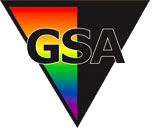
As morbid as it sounds, the Holocaust is my favorite historical period to study. Ever since reading The Diary of Anne Frank when I was in middle school, I've been fascinated by the plight of those oppressed by the Nazi regime. Since I was in Washington, D.C., last weekend for an Honors conference, I decided to stop by the United States Holocaust Memorial Museum--said to be one of the greatest in the world. Going through this museum and looking at each of the powerful exhibitions, I realized that, although many groups suffered at the hands of Hitler's army, the only people being featured in the museum were the Jewish victims. Being such an activist for LGBT awareness, I was frustrated and offended that those who wore the pink triangles and the black triangles were not being represented. In the gift shop, I did find one bookshelf primarily dedicated to the suffering of the homosexual males in concentration camps during World War II, but that was about it. What is it that makes the yellow star so much more important? Understandably, the Jews did make up the majority of the victims of the Holocaust, but the Jehovah's Witnesses, gypsies, communists, the disabled, the mentally ill, and so many others suffered greatly. We don't really get to hear much about that in the history books or, regrettably, in respectable historical museums.
Holocaust education isn't the only area in which Jewish oppression is seen as the only struggle worth noticing. When concentration camps were liberated in 1945 at the end of World War II, the only group not to be freed was comprised of homosexual males. Paragraph 175, anti-gay legislation in Germany, was still in effect during this time. Therefore, those who wore the pink triangle were forced to serve their full sentence for a "crime" they were accused of by Adolf Hitler. Seems logical, right? Although antisemitist attitudes began to change at the end of Hitler's reign, homophobic tendencies have only recently begun to possess the same taboo--and we still make excuses for or accept the opinions of those who express anti-gay sentiment. There is something seriously wrong with this picture.
I encourage everyone to learn more about the forgotten victims of the Holocaust--including the "antisocial" lesbian bearers of the black triangle, and the gay men who were forced to wear the pink triangle. Here are a few resources you might wish to browse that will give you more information on LGBT suffering during World War II:
http://en.wikipedia.org/wiki/Persecution_of_homosexuals_in_Nazi_Germany_and_the_Holocaust
http://www.ilga-europe.org/europe/issues/holocaust
http://www.lambda.org/symbols.htm
http://lesbianlife.about.com/od/herstory/f/BlackTriangle.htm
(Google related keywords... there are so many resources that I'd love to share!)






